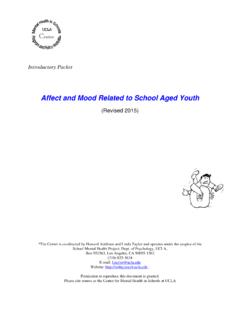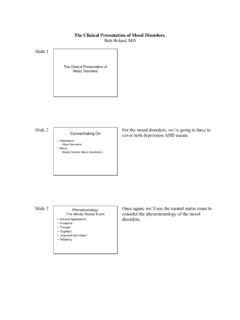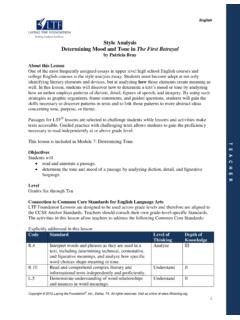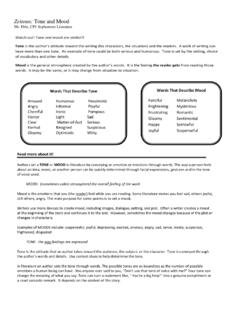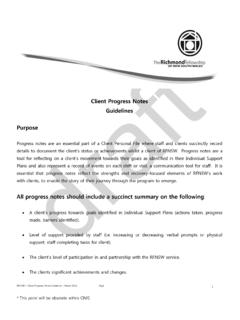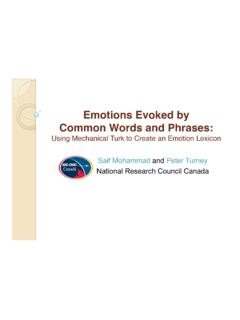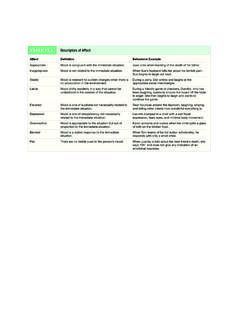Transcription of The Mental Status Examination - PBworks
1 The Mental Status Examination Uniformed Service University of the Health Sciences Department of Psychiatry Objectives: At the completion of the class, students should be able to: 1. describe the main components of the Mental Status Examination 2. Compose a Mental Status Examination based on a patient observation and interview 3. Recognize the difference between thought process and thought content 4. Estimate degree of psychopathology based on the Mental Status Examination 5. Document adequate safety (suicidal and homicidal) assessment of each patient The Mental Status Examination is an integral portion of the psychiatric interview.
2 It serves as a snapshot of the person you are evaluating. It should include all of the pertinent observations and findings you accomplish during your encounter with the patient. Not only is it important for describing the state of the patient, it is an important tool that can help substantiate a diagnosis, convey information to another provider, and assist in determining most appropriate step in treatment. Based on the following sections, the Mental Status Examination may appear quite involved and complicated.
3 This is not the case. As you will see, much of the information for the Mental Status Examination is obtained from the natural course of the interview. It is important to state that the goal is not pinpoint the absolute correct term to describe an observation. The beauty of the Mental Status Examination is, even if you do not know the specific term, you can use your own words and observations. APPEARANCE Yes, this is as straightforward as it sounds this section describes how the patient looks, smells, behaves, speaks, establishes eye contact, etc.
4 If this section is thorough enough, a reader of your Mental Status exam should be able to pick out the person out of a room. The Mental Status exam starts when you first set eyes on the patient. The following is a sample of items that should be included in the APPEARANCE section: Ethnicity Apparent age (younger, older, or appeared stated age) Sex Coordination/gait/notable movements Adherence to social conventions ( , shakes hands, military bearing) Build (Average, underweight, emaciated, petite, thin, obese, muscular) Grooming (Good, poor, adequate, immaculate, neglected) Dress (Casual, stylish, mismatched items, formal, tattered, appropriate for particular setting) Psychomotor activity (Described as increased in the case of agitation.)
5 Decreased in cases of depression or catatonia) Page 1 of 9 A description of how the patient relates to the interviewer is a necessary component of the APPEARANCE section. This is sometimes also described as the interpersonal style. Congenial Guarded Open/candid Cooperative Withdrawn Distant Annoyed/Irritable Engaging Hostile Shy Relaxed Cautious Defensive Resistant Speech is something you can also comment on in the APPEARANCE section. Some patients will speak volumes, while others will say only a few words.
6 Some patients will speak very fast, and others will not make any sense. A good speech section of the Mental Status Examination comments on the rate, rhythm, volume, and spontaneity. Some ways to help describe speech patterns are: Clear Coherent Normal rate Pressured (fast) Soft-spoken Stuttering Includes profanity Impoverished Monotone Mumbled Animated/Excited Difficulty finding words Slurred Spontaneous speech Confabulation Impressionistic/little detail No speech Poor articulation In describing speech, it would be appropriate to comment on what was said.
7 This can also be deferred to the THOUGHT content section; however, if there are prominent themes there should be a brief comment describing them. Eye contact is also described in the APPEARANCE section. Usually is described with one or more of the following: Good Fleeting Avoided Intense/unwavering None Sporadic Example of appearance section: Vicky is a 65 year old obese African American woman who appeared older than her stated age. She was dressed in a wrinkled, dirty (riddled with food stains), and obviously expensive red business suit with matching red bonnet, which made her appear overdressed for the intake interview.
8 Her hair was immaculately cut and styled; she also had copious amounts of make-up applied as well as dirty fingernails and mismatched earrings. She was noted to be quite gregarious, cooperative, and overly familiar with the interviewer, commenting on several occasions that the interviewer looked like her grandson, Dwayne. She had obvious, low, rhythmic motions of her lower jaw and tongue, as well as a slow tremor in her hands bilaterally these appeared not to bother her. Eye contact was noted to be intense and, at times, unwavering as she looked at the interviewer Page 2 of 9 with wide eyes.
9 Her manner of speech was noted to be quite loud accompanied with a pressured rate, rhythm, and spontaneity with overvalued content around hogs not being pigs. Johnny appeared to be his stated age of 30. He was a fairly tall, thin, and slightly balding Caucasian male. While he greeted the interviewer appropriately with a handshake, his palm was notably sweaty. He nervously and sheepishly apologized for this. Throughout the course of the interview, he tapped his fingers on his knees, looked around the room frequently, and smiled nervously every few seconds.
10 He was well-groomed, dressed in well-maintained in his Class B uniform, cooperative, and interactive throughout the entire interview. Eye contact was sporadic. Speech was of normal rate, rhythm, volume, and spontaneity; speech content was overrepresented with themes of worry. For example, these included worry whether he locked his car door or not and if he said hello to his boss this morning. mood and AFFECT mood describes the subjective state of the patient. This can be directly asked ( , What would you say your mood is right now?)

